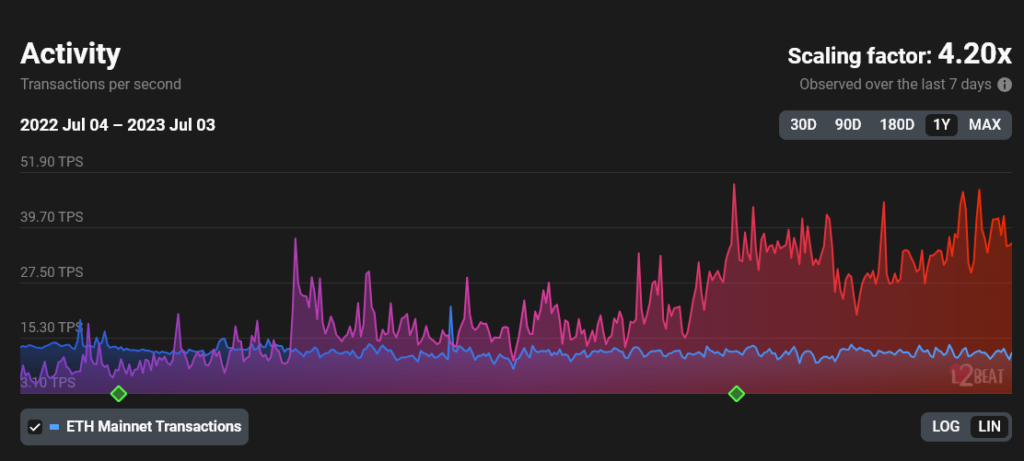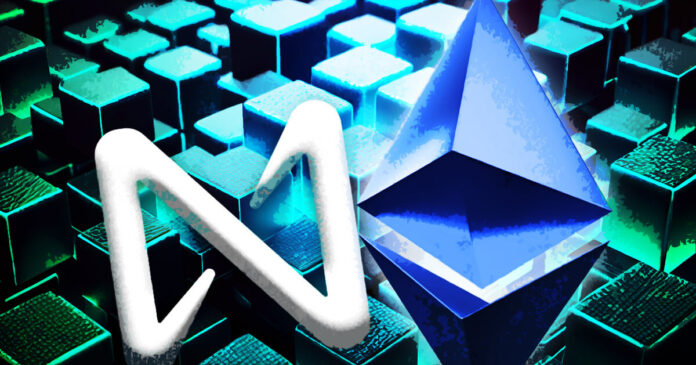The blockchain scalability panorama has developed considerably lately, with Layer 2 (L2) and sharding rising as the 2 dominant approaches.
Ethereum, a key participant within the crypto trade, adopted deployment-centric L2s to scale its community, whereas the NEAR protocol took a unique route, opting to scale by way of sharding. Each methods supply distinctive options to blockchain scalability, however additionally they current their very own challenges.
Ethereum Layer 2s: A Cumulative Method
NEARWEEK, a NEAR protocol publication, praised Ethereum for garnering vital consideration for its progressive rollup-centric scaling technique. An L2 protocol is constructed on prime of an present blockchain to enhance scalability, throughput, and privateness. That is achieved by executing off-chain state transitions from the Layer 1 (L1) on which they’re constructed and committing state roots and transactional knowledge to the underlying L1.
NEAR considers the driving philosophy behind rollups to be the idea {that a} rollup can outperform the underlying L1 in throughput resulting from decreased consensus overhead. Nonetheless, in apply, NEAR believes the general scaling achieved by the rollups has been considerably disappointing, barely exceeding what a single rollup can ship.
Nonetheless, knowledge from L2 analytics platform L2Beat provides a blended image as a result of improve in L2 exercise over the previous 12 months, as proven within the graph beneath.

Moreover, reviewing the highest 10 Ethereum L2 exhibits that Arbitrum One and zkSync Period are approaching Ethereum’s month-to-month transaction depend. Moreover, Immutable X and Arbitrum Nova outpaced Ethereum’s progress in seven-day common transactions per second (TPS). Notably, Ethereum had a better energetic TPS than any L2 scaling answer on the community on July 3.
| # | Identify | Final day’s GST | 7D change | Most every day GST | 30D account | The info supply |
|---|---|---|---|---|---|---|
| 1 | Ethereum | 12.29 | 6.48% | 22.37 (09 December 2022) | 31.45M | Blockchain RPC |
| 2 | First arbitration | 9.69 | -4.17% | 31.64 (23 March 2023) | 24.81 million | Blockchain RPC |
| 3 | zkSync period | 8.63 | -14.74% | 12:00 p.m. (Could 16, 2023) | 22.27 million | Blockchain RPC |
| 4 | Major community OP | 6.00 | -12.97% | 9.26 (January 12, 2023) | 14.82M | Blockchain RPC |
| 5 | dYdX | 3.09 | -38.54% | 11:45 a.m. (February 15, 2022) | 9.42M | Closed API |
| 6 | X immutable | 2.01 | 7.47% | 39.35 (March 11, 2022) | 5.67 million | Closed API |
| 7 | Starknet | 1.79 | -9.17% | 3.05 (Could 16, 2023) | 4.61 million | Explorer API |
| 8 | Arbitrum Nova | 1.34 | 18.15% | 10.93 (April 27, 2023) | 2.99 million | Blockchain RPC |
| 9 | Summit | 0.95 | 2.27% | 1.38 (April 13, 2023) | 2.68 million | Closed API |
| ten | zkSync Lite | 0.89 | -27.20% | 3.29 (21 March 2023) | 2.52 million | Explorer API |
| 11 | Polygon zkEVM | 0.64 | -5.13% | 0.82 (June 13, 2023) | 1.34 million | Blockchain RPC |
Knowledge from L2Beat.com
Nonetheless, the principle reason for the poor efficiency prompt by NEAR is attributed to the truth that fashionable Ethereum decentralized purposes (dApps) run on virtually all rollups, leading to “duplication” of comparable transactions on completely different rollups.
NEAR’s fragment-centric strategy
NEAR Protocol has, quite the opposite, chosen to deal with scalability by way of sharding, which partitions the community into distinct segments built-in instantly into the protocol. In response to NEARWEEK, every fragment of NEAR’s structure may be likened to an optimistic accumulation in Ethereum’s strategy.
The principle benefit of NEAR’s partitioning strategy is its composability, which permits purposes in a single partition to natively work together with purposes in one other partition. This constant partitioning mannequin permits purposes to work together in the identical method whether or not or not they’re deployed on the identical partition, liberating builders from deciding which partition to deploy their purposes.
Moreover, NEAR’s partitioning mannequin supplies sooner transaction finality, sometimes inside two to a few seconds, surpassing prolonged finality instances within the rollup universe.
Though the NEAR protocol doesn’t record its real-time TPS on the block explorer, it may be calculated primarily based on the newest block knowledge. A forexcryptozone NEAR block explorer transaction evaluation confirmed a median TPS of round 5.7 transactions per second on July 4th. This snapshot of NEAR’s TPS aligns with the 5 main L2s of the Ethereum community. The NEAR neighborhood predicts that the potential of the protocol by way of sharing will attain 100,000 TPS sooner or later.
Contrasting design philosophies
The completely different scaling approaches taken by Ethereum and NEAR spotlight their contrasting design philosophies. Whereas Ethereum prioritizes resiliency, sustaining a easy L1 protocol design, NEARWEEK mentioned NEAR Protocol leans in the direction of a simplified consumer expertise, supporting further protocol complexity to make sure superior UX.
Additionally, you will need to observe that NEAR doesn’t intention to be “simply an L1” because it seeks to operate as a Blockchain Working System (BOS), offering a common layer for searching and discovering open internet experiences. Via the BOS, NEAR goals to
“allows builders and customers of assorted blockchains, together with Ethereum Layer 2, to construct and use purposes throughout a large number of blockchain ecosystems.”
Extra particulars on NEAR’s BOS imaginative and prescient may be discovered on his Medium account.
Blockchain scalability stays a fancy and important challenge within the crypto world. As Ethereum rollup-centric L2s and NEAR sharding evolve, will probably be attention-grabbing to see which strategy proves handiest in the long term.
